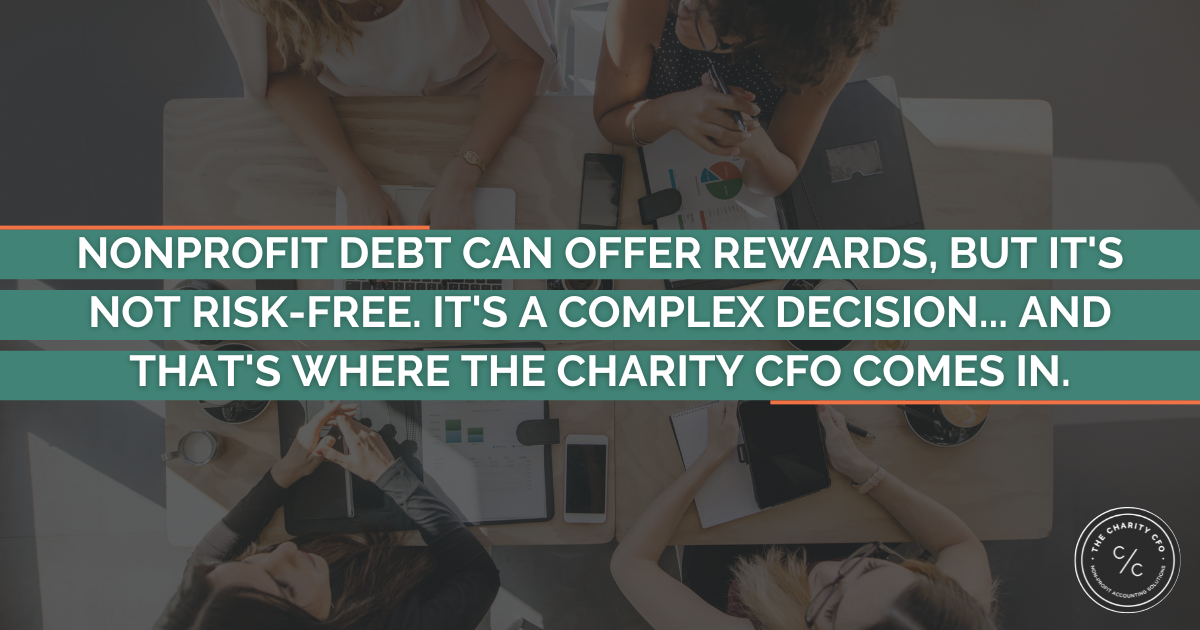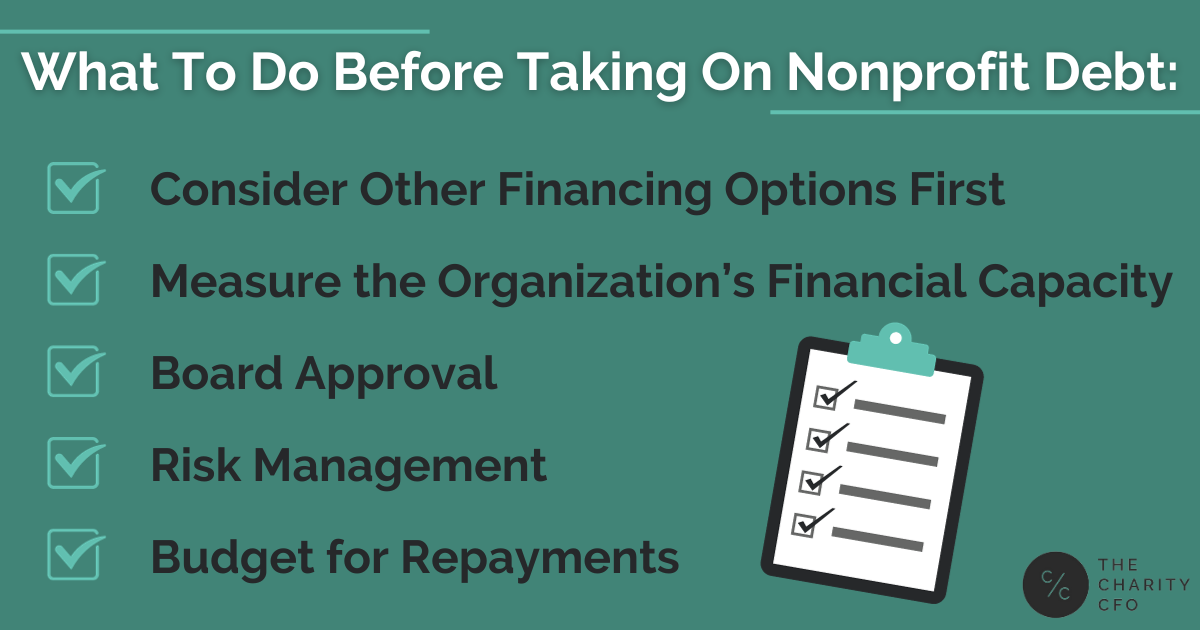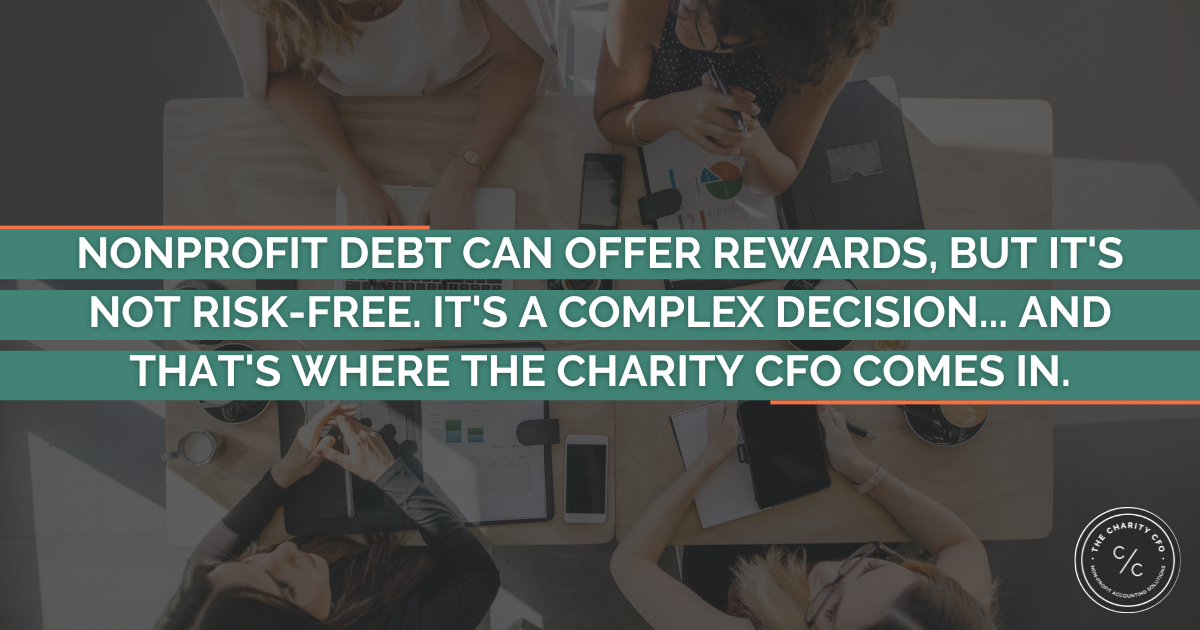If you’re like most nonprofit leaders, you probably have questions — and possibly mixed feelings — about nonprofit debt. That’s because you’ve also probably received mixed messages about nonprofits and debt.
Nonprofits aren’t often encouraged to take on debt. But while studies show that Charity Navigator gives higher ratings to organizations with lower liability-to-asset ratios, studies indicate that holding no debt isn’t optimal, either.
When the right type of debt is taken on methodically, thoughtfully, and for the right reasons, it can be a useful tool that helps a nonprofit gain financial flexibility. The key lies in ensuring debt is carefully managed, and aligned with the organization’s mission and financial capacity.
Here’s what you need to know about nonprofit debt.
Reason for Nonprofit Debt
Let’s start with the basics, a.k.a. the why behind nonprofit debt. As a general rule, the purpose of any debt must be centered on furthering the mission.
Perhaps this means taking on debt in order to grow programs and services. The money could be used to hire staff, expand a service area, or launch new initiatives. Maybe your organization needs to fund a capital campaign, cover operating expenses, or make payroll in the event of donation or grant shortfalls.
Whatever the reason, the decision to take on debt should only be made if it advances the organization’s goals.
Types of Debt for Nonprofits
There are a variety of different types of debts, each with advantages and disadvantages. While this isn’t an all-inclusive list, let’s look at a few common types of debt.
Long-Term Loans
Long-term loans usually have a term of one year or more. They may be used to finance capital projects, to purchase real estate, make building improvements, or to expand services.
A long-term loan provides improved financial flexibility, with the ability to make payments over a longer period of time. That means monthly payments may be lower. In some cases, an organization may have to provide collateral to obtain a long-term loan.
This type of loan is typically a term note payable over a period of time with fixed payments.
Lines of Credit
A nonprofit line of credit offers access to funds on an as-needed basis. Credit lines can be useful to cover short-term budget shortfalls or unexpected expenses.
Most lines of credit would require collateral and likely a guarantee from someone at the nonprofit (typically the founder or a board member). Given that these are short-term advances, it is imperative that a nonprofit has a plan to replay the line of credit.
Pro Tip: we strongly advise against giving any sort of personal guaranty for a line of credit.
Program-Related Investments
Program-related investments, also known as PRIs, are loans made by grantors, such as foundations. When used to further a specific purpose of the foundation, this type of debt incurs some tax benefits on the lender.
While PRIs must be paid back, they generally offer below-market interest rates.
Mortgages
A mortgage loan might be a reasonable type of debt for a nonprofit that owns property. A mortgage can be used to purchase or renovate a property.
A mortgage loan may offer low-interest rates over the long term.
Each type of debt offers pros and cons. Be sure to speak with a trusted accountant before taking on any debt.
What To Do Before Taking On Nonprofit Debt
Carefully consider your options before taking on debt. Identifying your organization’s needs, financial capacity, and risk tolerance level will help you decide which type of debt, if any, would be a good choice for your nonprofit.
Consider Other Financing Options First
Before taking on debt, look at other funding sources. Explore other options for bringing in revenue, such as fundraising campaigns, grants, and government funding.
Measure the Organization’s Financial Capacity
Take stock of your nonprofit’s financial capacity so you can make fully informed decisions about debt. It’s imperative to assess your financial situation to ensure that you’ll be able to repay the debt. Take revenue, expenses, assets, and liabilities into account.
Board Approval
Taking on debt isn’t a decision you want to make unilaterally. Discuss debt options and alternatives with the board. Don’t make any moves without the board’s full knowledge, buy-in, and approval.
Risk Management
Financial decisions often come with risks as well as rewards. Develop a plan to mitigate the risks associated with taking on debt. Consider developing a contingency plan if unexpected financial problems arise.
Budget for Repayments
In most cases, nonprofits do not consider debt repayments in their financial budgets each year as most budgets include simply revenues and expenses to be received or incurred during that year. If your organization does not have an existing reserve balance that can help repay debt payments, consider how much cash you need for both ongoing operating expenses and debt repayments when figuring out your fundraising targets. Simply put, add up your expenses plus your debt repayments plus your cash outlay for capital payments to come to a total fundraising goal for the year.
Thinking of Taking on Nonprofit Debt?
Debt can help nonprofits be more financially agile — but only if it’s managed correctly and taken on for the right reasons. Debt should always be in mission alignment and further organizational goals.
Before taking on debt:
- Compare the pros and cons of different types of debt, such as long-term loans, credit lines, PRIs, and mortgages
- Assess your organization’s financial capacity and risk tolerance
- Explore other funding avenues such as grants
- Get board approval
- Develop a risk management and contingency plan
- Include cash needed for debt repayment into your financial budget
Nonprofit debt can offer rewards, but it’s not risk-free. It’s a complex decision… and that’s where The Charity CFO comes in.
Our team will help you navigate this complex financial issue, so you can determine if (and which type of) debt is the right choice for your organization’s unique needs. Contact us today to learn more.

Do You Struggle to Make Sense of Your Financial Statements?
Get our FREE GUIDE to nonprofit financial reports, featuring illustrations, annotations, and insights to help you better understand your organization's finances.
Get the free guide!




0 Comments